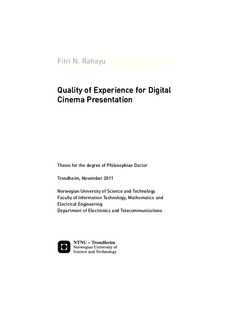| dc.contributor.author | Rahayu, Fitri N | nb_NO |
| dc.date.accessioned | 2014-12-19T13:47:08Z | |
| dc.date.accessioned | 2015-12-22T11:46:09Z | |
| dc.date.available | 2014-12-19T13:47:08Z | |
| dc.date.available | 2015-12-22T11:46:09Z | |
| dc.date.created | 2012-02-28 | nb_NO |
| dc.date.issued | 2011 | nb_NO |
| dc.identifier | 506308 | nb_NO |
| dc.identifier.isbn | 978-82-471-3123-7 | nb_NO |
| dc.identifier.uri | http://hdl.handle.net/11250/2370392 | |
| dc.description.abstract | Multimedia presentations of digital media services and devices are meant for human consumption and interaction. Before consumption by the user, the multimedia signal usually goes through several processing stages. Depending on the technologies, including the applied signal processing algorithms, some stages can introduce artefacts that reduce the quality of the multimedia presentation. Quality is a fundamental aspect for the design of any end-to-end multimedia signal processing architecture. A sufficiently high quality level of any multimedia presentations must be provided to the user to ensure her optimal experience. More recently, we have seen a shift of paradigm towards incorporating the user as the most important factor in the quality assessment of multimedia presentations. This shift of paradigm drives the creation of the Quality of Experience (QoE) concept. QoE depends on the user perception making it a qualitative assessment as opposed to a purely quantitative one. The definite way of assessing perception of user is by conducting a perception experiment involving human participants in a controlled environment, and this experiment must be carefully designed. Subjective quality assessment is one example of such experiment. There is another, more practical way of assessing quality from user standpoint; this utilizes perceptual-based metrics that model the human perception as closely as possible. Due to the array of current applications, it is unlikely to have a universal quality metric for assessing QoE of multimedia applications. This thesis will only focus on QoE for Digital Cinema presentations.
The thesis is composed of a paper collection; were we have classified the work in this thesis based on research questions within three main themes: QoE of still images for Digital Cinema presentation1, QoE of motion pictures for Digital Cinema presentation, and QoE of audiovisual presentation for Digital Cinema.
In the field of QoE of images for Digital Cinema presentations, we conducted subjective image quality assessments for Digital Cinema using a methodology derived from standardized recommendations. During the assessment we collected subjective scores of the perceived image quality in a real Digital Cinema environment. We also conducted another perceptual experiment in a Digital Cinema to obtain the parameters of Multi Scale Structural Similarity (MS-SSIM) objective metric for Digital Cinema presentation. Moreover, we analysed the performance of several objective metrics including MS-SSIM with original parameters and parameters obtained from our experiment in the Digital Cinema. The results show that in the case of Digital Cinema, MS-SSIM does not exhibit the same type of performance that has been reported in the literature, when compared to PSNR metric. I
n the field of QoE of motion pictures for Digital Cinema presentations, we conducted subjective motion pictures quality assessment for Digital Cinema using a careful designed experiment, which is also derived from standardized recommendations. The collected subjective data is used to analyse the performance of two compression algorithms (JPEG 2000 and AVC/H.264) for a Digital Cinema environment; the results showed that temporal compression schemes like H.264/AVC have high coding efficiency not only at SD resolutions, but also at high resolutions for Digital Cinema presentation. Furthermore, we performed an analysis on factors that affect visual perceived quality in a Digital Cinema using collected scores from the subjective still images and motion pictures quality assessment.
In the field of QoE of audiovisual presentation for Digital Cinema, we performed subjective experiments of audiovisual contents for Digital Cinema using also methodology derived from standardized recommendations. In addition, we investigated the multimodal effect on perceived quality in a Digital Cinema environment. A major result of our subjective visual quality assessment showed that the presence of audio (low or high quality) does not influence the visual quality judgment | nb_NO |
| dc.language | eng | nb_NO |
| dc.publisher | Norges teknisk-naturvitenskapelige universitet, Fakultet for informasjonsteknologi, matematikk og elektroteknikk, Institutt for elektronikk og telekommunikasjon | nb_NO |
| dc.relation.ispartofseries | Doktoravhandlinger ved NTNU, 1503-8181; 2011:277 | nb_NO |
| dc.relation.haspart | Rahayu, Fitri N.; Reiter, Ulrich; Ebrahimi, Touradj; Perkis, Andrew; Svensson, Peter. SS-SSIM and MS-SSIM for Digital Cinema Applications. Proceedings SPIE-IS&T Human Vision and Electronic Imaging XIV Vol. 7240, San Jose, USA, 2009, 2009. 10.1117/12.805805. | nb_NO |
| dc.relation.haspart | Rahayu, F.N.; Reiter, U.; Nielsen, M.T.M; Ebrahimi, T; Perkis, A.. Comparison of JPEG 2000 and H.264/AVC by subjective assessment in the Digital Cinema. Proceedings of 2nd IEEE International Conference on Quality of Multimedia Experience: 112-117, 2010. 10.1109/QOMEX.2010.5517784. | |
| dc.relation.haspart | Rahayu, F.N; Ebrahimi, T; Perkis, A. Exploring alternative content in Digital Cinema. Proceedings 16 th IEEE International Conference on Virtual Systems and Multimedia (VSMM), Seoul, Korea, 2010: 295-296, 2010. 10.1109/VSMM.2010.5665948. | |
| dc.relation.haspart | Rahayu, F.N; Reiter, U; Junyong, You; Perkis, A; Ebrahimi, T.. Subjective Visual Quality Assessment in the Presence of Audio for Digital Cinema. Proceedings 3rd IEEE International Conference on Quality of Multimedia Experience, Mechelen, Belgium, September 2011: 113-118, 2011. 10.1109/QoMEX.2011.6065687. | |
| dc.relation.haspart | Rahayu, Fitri N.; Reiter, Ulrich; Ebrahimi, Touradj; Perkis, Andrew. A Study of Quality of Experience in D-Cinema. , 2011. | |
| dc.title | Quality of Experience for Digital Cinema Presentation | nb_NO |
| dc.type | Doctoral thesis | nb_NO |
| dc.contributor.department | Norges teknisk-naturvitenskapelige universitet, Fakultet for informasjonsteknologi, matematikk og elektroteknikk, Institutt for elektronikk og telekommunikasjon | nb_NO |
| dc.description.degree | PhD i elektronikk og telekommunikasjon | nb_NO |
| dc.description.degree | PhD in Electronics and Telecommunication | |
